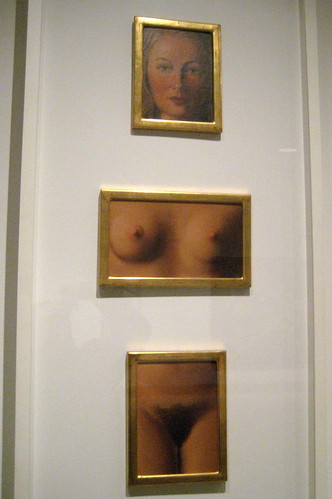NYC - Metropolitan Museum of Art: René Magritte's The Eternally Obvious

1948
René Magritte (Belgian, 1898-1967)
Oil on canvas laid on board; Overall (installed size, 5 framed panels): 72 x 16 in. (182.9 x 40.6 cm)
Magritte painted the body of a naked blonde model, cut from the canvas the body's five choicest bits, surrounded them in gold frames, and reassembled the figure with blank spaces in between on a sheet of glass. This work is a variant of the artist's famous, same-titled prototype from 1930 for which his wife Georgette posed. In that earlier work, Georgette's face is seen in three-quarter view, she stands in a contrapposto stance, and her body is not as rigidly aligned frontally as in this later work, for which the artist chose a younger model with firmer breasts. Magritte plays tricks with our perception in these "picture-objects," whose famethat of the earlier versioncoincided with its role in the cult of the Surrealist object in the 1930s. Although the body is truncated, we automatically fill in the missing areas and see a "complete" nude woman, never mind that her arms and hands are missing.
The artist's dealer in New York, Alexander Iolas, wanted to show this work in an exhibition at his gallery in 1948. Concerned that the painting would not pass inspection by U.S. Customs, Iolas ordered Magritte to omit the pubic hair. Another artist from the Iolas gallery, Bernard Pfriem, restored the hair in his studio on Prince Street in New York.
The Pierre and Maria-Gaetana Matisse Collection, 2002 (2002.456.12a-f)
**
The Metropolitan Museum of Art's permanent collection contains more than two million works of art from around the world. It opened its doors on February 20, 1872, housed in a building located at 681 Fifth Avenue in New York City. Under their guidance of John Taylor Johnston and George Palmer Putnam, the Met's holdings, initially consisting of a Roman stone sarcophagus and 174 mostly European paintings, quickly outgrew the available space. In 1873, occasioned by the Met's purchase of the Cesnola Collection of Cypriot antiquities, the museum decamped from Fifth Avenue and took up residence at the Douglas Mansion on West 14th Street. However, these new accommodations were temporary; after negotiations with the city of New York, the Met acquired land on the east side of Central Park, where it built its permanent home, a red-brick Gothic Revival stone "mausoleum" designed by American architects Calvert Vaux and Jacob Wrey Mold. As of 2006, the Met measures almost a quarter mile long and occupies more than two million square feet, more than 20 times the size of the original 1880 building.
In 2007, the Metropolitan Museum of Art was ranked #17 on the AIA 150 America's Favorite Architecture list.
The Metropolitan Museum of Art was designated a landmark by the New York City Landmarks Preservation Commission in 1967. The interior was designated in 1977.
Δεν υπάρχουν σχόλια:
Δημοσίευση σχολίου